ApnaPC: Bringing Technology to Every Indian Home
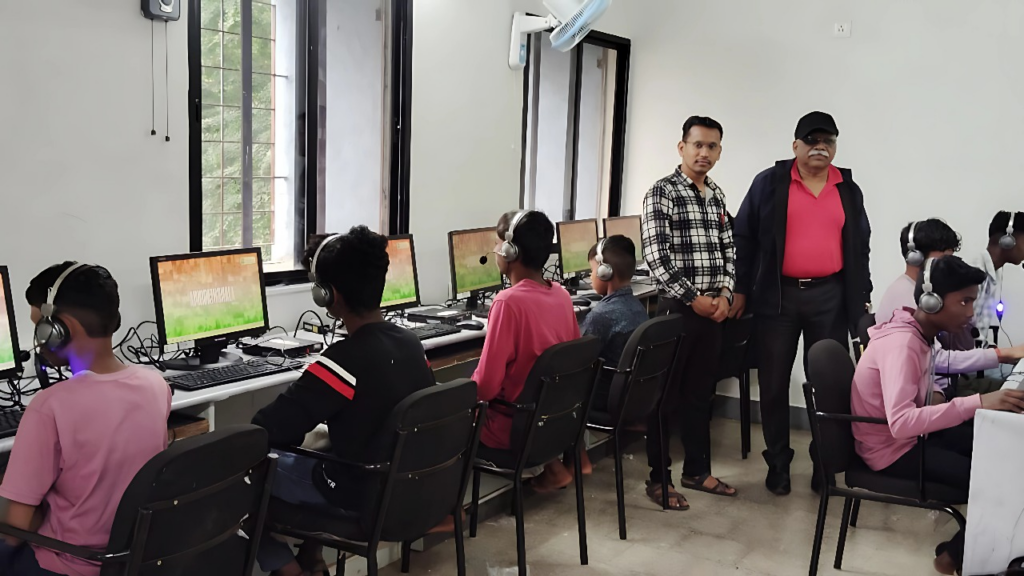
Let’s imagine a world where every student, teacher, and professional has the tools they need to chase their goals. Sounds ideal, right? But for many families in India, owning a computer feels like an impossible dream—something only a few can afford. At Apni Pathshala, we believe that every child deserves a chance to dream bigger. That’s why we created ApnaPC—a computer designed to empower learners, bridge gaps, and unlock potential. Through this Q&A, we’ll explore everything about ApnaPC and how it’s changing lives across the country. 1. What is ApnaPC, and why was it created? ApnaPC is a specially designed computer created by Apni Pathshala to help learners—students, teachers, and professionals—access affordable technology. We noticed a huge problem: many students in India don’t have access to computers, making it hard for them to learn, grow, or compete in the digital world. ApnaPC solves this by providing a high-quality computer at minimal cost, equipped with all the tools needed for education and skill-building. 2. When did the ApnaPC initiative start? The ApnaPC initiative was officially launched on January 1, 2025. Since then, it has been transforming the way people in India access education and technology. 3. Who can apply for ApnaPC? Currently, ApnaPC is available to learning pods and community leaders who use these computers to teach and support others in their communities. This ensures that ApnaPC benefits large groups of learners. In the future, we plan to expand our initiative, allowing individual students and families to apply through a Google form. This form will let us understand your needs and assess how we can help you. 4. How can I apply for ApnaPC? As already mentioned above, as of now, ApnaPC is available to learning pods and community leaders. They can apply through our initiative to receive computers for their programs. In the future, we’ll introduce a Google form application process, where individuals can share their requirements and proposals to qualify for ApnaPC. Stay tuned for updates! 5. Why is ApnaPC so affordable? We believe education should not depend on a family’s financial situation. ApnaPC is budget-friendly because we want to make technology accessible to everyone. While similar computers cost ₹30,000–₹40,000, ApnaPC is offered at a much lower price with no rental fees. 6. What’s inside an ApnaPC? ApnaPC is more than just a computer—it’s a complete setup designed for learning. Each ApnaPC includes: 7. What are the different ApnaPC models? We’ve designed two models to meet different needs: 8. What tools and apps come with ApnaPC? ApnaPC comes preloaded with amazing tools to make learning exciting: 9. How is ApnaPC helping India’s digital growth? India’s biggest challenge is bridging the gap between urban and rural education. By making technology affordable and accessible, ApnaPC is: 10. How durable is ApnaPC? ApnaPC is built to handle tough conditions. 11. What is Apni Pathshala’s ultimate vision? Our vision is to bring digital growth and literacy to every corner of India. We want to ensure that no student or learner is left behind because of a lack of resources. Through ApnaPC, we hope to build a future where technology is accessible, education is inclusive, and every dream has a chance to come true. 12. What’s next for ApnaPC? We’re constantly working to make ApnaPC better and more accessible. Our future plans include: 14. Why should you choose ApnaPC? ApnaPC is not just a computer, it’s a tool for empowerment. Here’s why it’s the right choice: Be Part of the Change! ApnaPC is more than a product—it’s a mission to create opportunities, break barriers, and bring technology to every Indian home. Whether you’re a student, teacher, or community leader, ApnaPC is here to help you achieve your dreams. Contact Apni Pathshala to start your journey today with ApnaPC! Together, we can build a brighter future for India.
Hope in Raigad: How Apni Pathshala Revolutionized Education for Tribal Kids?
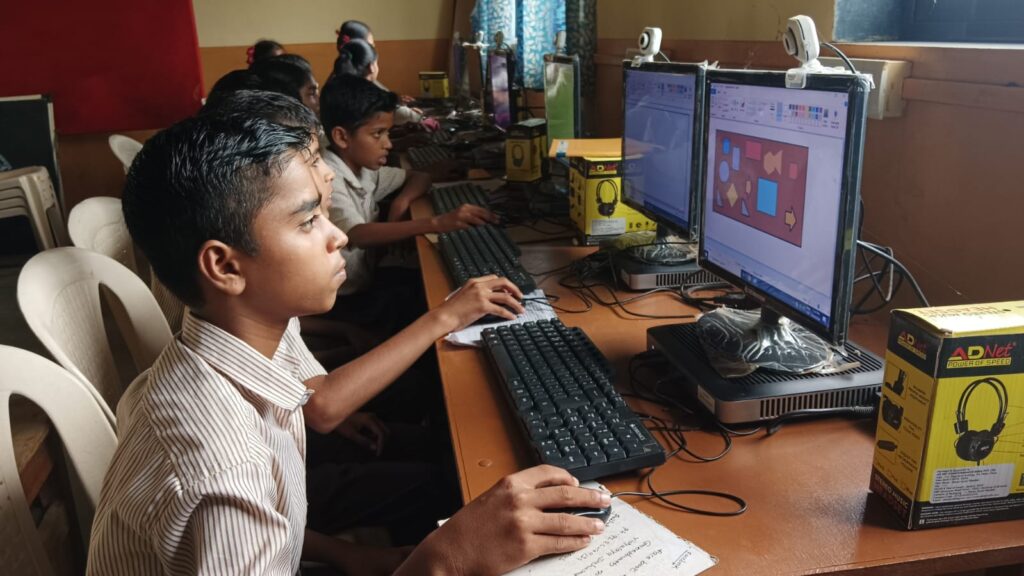
Two years ago, in a tiny village in Raigad, Maharashtra, there was a school that barely seemed to stand a chance. It had one computer. No internet. The lights flickered more often than they worked correctly. For most kids, the idea of “technology” was something they’d only heard about. This was Shri Ganeshnath Maharaj Vidyalaya, a school serving tribal and underprivileged families. A place where dreams existed but had no action plan. Kids would miss school to help their parents with fishing nets or farmwork. Parents, struggling to survive, thought education was a luxury they couldn’t afford to care about. It felt like the story of this school might end before it really began. But then, something incredible happened. And it started with one simple word: hope. Where there is determination, miracles happen. And one such miracle arrived in the form of ApniPathshala. The Entry of Apni Pathshala It all began with a conversation in the village. Someone mentioned an organization called Apni Pathshala, a group known for turning struggling schools into success stories. A group that has been known to give wings to dreams. It sounded almost too good to be true. But the school reached out anyway, because what did they have to lose? What happened next felt nothing short of a prayer come true. Apni Pathshala didn’t just show up with a check, they showed up with a vision. Within weeks, they had brought in personal computers, learning materials, and the belief that this school, these kids, could achieve the extraordinary. For a school that had been struggling with just one computer and no internet, this was similar to opening the doors to a world of endless possibilities For children who’d never touched a keyboard before, seeing a row of computers in their classroom felt like stepping into another world. And that’s when everything started to change. Overcoming the Challenges The initial days weren’t easy at all. As already mentioned before, most children had never seen a computer before, let alone used one. Their tiny fingers hesitated on keyboards, their eyes widened at screens displaying lessons. Their teachers, who had the habit of using chalkboards and textbooks, found this as a challenging task. But, where there is will, there is a way. They themselves started learning alongside their students. Yes, mistakes were plenty, but so was the determination to figure it out. Slowly but surely, confidence began to grow. Children who had once been too shy to even try now looked forward to their daily computer class. They’d eagerly wait for the routine classes to get over to spend an hour discovering a world that had always seemed out of reach. The tables turned in such a way that even on Sundays and other holidays, their excitement to learn computers was unmatchable. Today, these same kids are managing the school’s social media pages and website. Yes, you read that right—these are the same children who, just two years ago, didn’t even know what a “cursor” was. Changing Lives Beyond the Classroom So usually what happens is that in Maharashtra, computer education typically gains importance after Class 10, often viewed as the final milestone in school education before getting to college. But at Shri Ganeshnath Maharaj Vidyalaya, now the students as young as those in Class 7-8 are getting the kind of knowledge that was previously reserved for their seniors. What was once a privilege for a select few has become an extremely important part of their everyday lives. This progress has been life-changing for the families, too. Most parents in the region are uneducated—fishermen, daily wage laborers, and tribal workers who once saw education as something only the rich can afford. Initially, both parents and children treated the school with indifference. Kids would often accompany their parents to work rather than attend classes. But oh how the tide has turned. Today, these very families view education as a lifeline, a path to a better future. Children who once helped with fishing nets are now confidently typing away on computers, their eyes filled with dreams of a brighter tomorrow. And with every child who learned something new, the village found a little more hope. A Vision for Tomorrow The school’s long-term vision is as inspiring as its present achievements. The coordinator shared a heartfelt aspiration, that one day, the students who graduate from Shri Ganeshnath Maharaj Vidyalaya will return to give back to the institution that shaped them. The dream is to create a self-sustaining model where former students contribute to the school’s growth, ensuring its legacy continues for generations to come. Currently operating entirely on donations, the school’s ultimate goal is to empower its students not just to learn but to lead. To carry forward the torch of education and uplift their communities. It’s a big dream for a school that still runs entirely on donations. But if the last two years have taught them anything, it’s this: dreams that seem impossible at first are often the ones most worth fighting for. The Heartbeat of the School: Its Teachers At the center of it all are the teachers. In a world where education has become business and teachers- are “employees”, here things are different. They aren’t just educators. They’re dreamers, believers, and tireless workers. When asked what keeps them going, one teacher’s words stood out: “It’s simple. The life of a teacher is the life of their students. Making my students’ lives better is what keeps me going. When my students succeed, my life feels complete.” Goosebumps. Really. This level of dedication is the reason this school is growing and reaching new heights. Also, when asked if he had a message to share, the same teacher’s response was both humble and powerful: “As teachers, if we don’t think of our students, who will? It is our responsibility to take care of them and ensure they have a better life.” A Story That’s Just Beginning Looking back at this beautiful journey, one thing is clear: when organizations
How can technology support alternative schooling models?
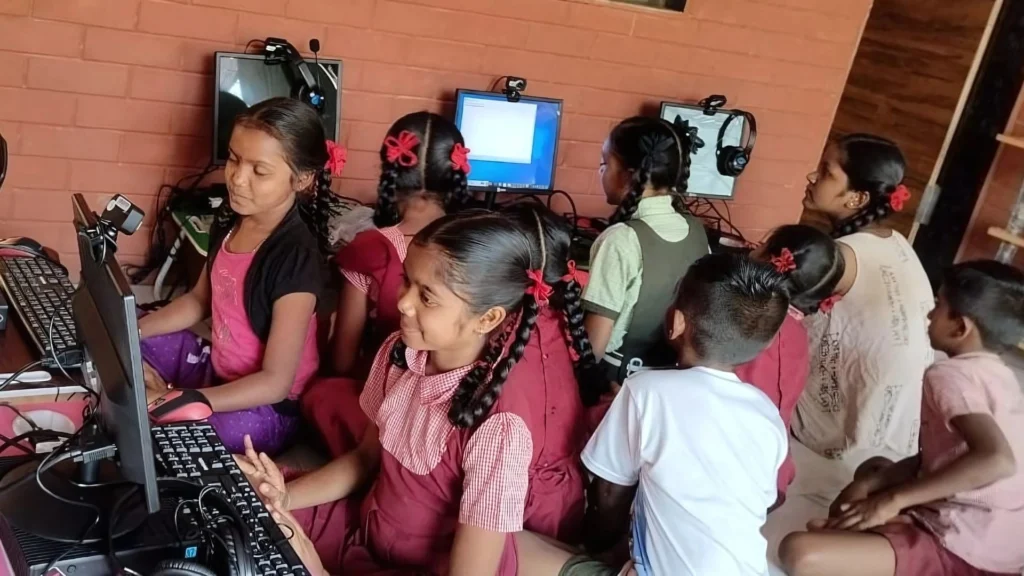
Welcome to the Future of Education A child sitting at home, building a robot while another explores the pyramids of Egypt through virtual reality—all part of their daily school routine. Sounds so movie- coded, right? It’s happening today, thanks to alternative schooling models and the power of technology. Whether it’s homeschooling, online academies, or Montessori setups, these approaches are redefining education. But what causes this shift? Technology, obviously. It’s the glue that holds these all models together, offering flexibility and endless opportunities. Enough talking around the bush, now let’s get straight to the point as how technology helps in alternative schooling models: 1. Personalized Learning Let’s be honest, traditional classrooms often fail to focus on individual needs. Some kids understand algebra in minutes, others struggle for weeks. Alternative schooling, powered by technology, changes that narrative. Your kid can learn maths via gamified learning or youtube lessons that simplify it.Imagine your child learning math through an app like Khan Academy, where the lessons adjust to their pace. Got a young artist at home? Apps like Procreate allow them to create digital masterpieces, blending education with creativity. How does it help? 2. Global Classrooms Gone are the days when education was confined to your city or country. Technology connects students to a world of resources and experts. You may be from a small village and your teacher can be from the USA or UK. Imagine telling all of these things to your ancestors from hundreds of year back- they might get a stroke😭 Virtual Field TripsWho needs a plane ticket to visit the Louvre? Platforms like Google Arts & Culture let students roam through museums, historical landmarks, and even outer space—all from their living rooms. I bet you must be like Damn, kids these days are so lucky! Learning from the BestWith online platforms like Coursera and MasterClass, students can learn coding from MIT professors or cooking from world-famous chefs. This global exposure prepares them for a connected world. Benefits for Alternative Schooling Models 3. Socialization in the Digital Age Critics often argue that alternative schooling lacks socialization. But here’s the truth: technology is building stronger, more diverse communities than ever. How It’s Happening Before you tag this article and write long twitter and linkedin posts, let me tell you- yes, it’s different from playground banter. And real human conversations are really important but these “online” connections often run deeper, teaching kids empathy, teamwork, and global citizenship. 4. Flexibility: Learn Anytime, Anywhere One of the biggest perks of alternative schooling is flexibility. Add technology to the mix, and the possibilities are endless.Your child can be an early bird who loves studying before sunrise. But school starts after 8-9 when his mind does not work in full capacity. No problem. Recorded lectures, online courses, and mobile-friendly apps ensure they can learn at their peak energy. What are some of the helpful tools? 5. Skill Development In today’s world, having book smarts isn’t enough. All the teachers, big CEO’s and even our prime minister have called out the importance of having skills. Alternative schooling emphasizes skills like coding, critical thinking, and creativity—and technology is the perfect partner for this mission. Practical Learning These skills aren’t just for resumes. They give confidence, problem-solving abilities, and a lifelong love for learning. These learnings give necessary exposure that is absolutely necessary for kids to have. 6. Inclusivity Education should be a right, not a privilege. Technology bridges gaps for students with disabilities, those in remote areas, or families with limited resources. Accessible Tools Apni Pathshala’s role in bridging innovation and tradition At Apni Pathshala, we believe every child deserves an education as per their needs and dreams. By providing PC’s to learners who truly need it but aren’t able to afford it, we are writing a new story of change. With a compassionate approach, we empower kids exploring alternative schooling models like learning pods and microschools. What do we offer? Overcoming Challenges with Tech in Alternative Education While technology opens incredible doors for alternative schooling, it’s not without its challenges. Addressing these challenges ensures smoother implementation and greater benefits for everyone. 1. Screen Time Concerns Ah, the major problem of parents around the world. Spending excessive time on screens can lead to physical and mental health issues, such as eye strain, disrupted sleep patterns, and even reduced attention spans in children. Solutions: 2. Digital Divide Even today access to reliable internet and devices remains a significant barrier. And, this happens particularly in rural or low-income areas. Solutions: 3. Tech Overload and Burnout Too many platforms, apps, and tools can overwhelm students and educators, leading to frustration and reduced productivity. Solutions: Considering the changing times, technology isn’t just a tool, it’s a lifeline for alternative schooling models. From personalizing education to making it accessible for all, the possibilities are limitless. Whether you’re a parent, educator, or curious learner, embracing technology can open doors to a brighter future.At Apni Pathshala, we’re here to guide you every step of the way. Together, let’s start this journey together. Connect with us, now!
How Narayan Chandra Trust and Apni Pathshala are Changing Lives with Digital Education
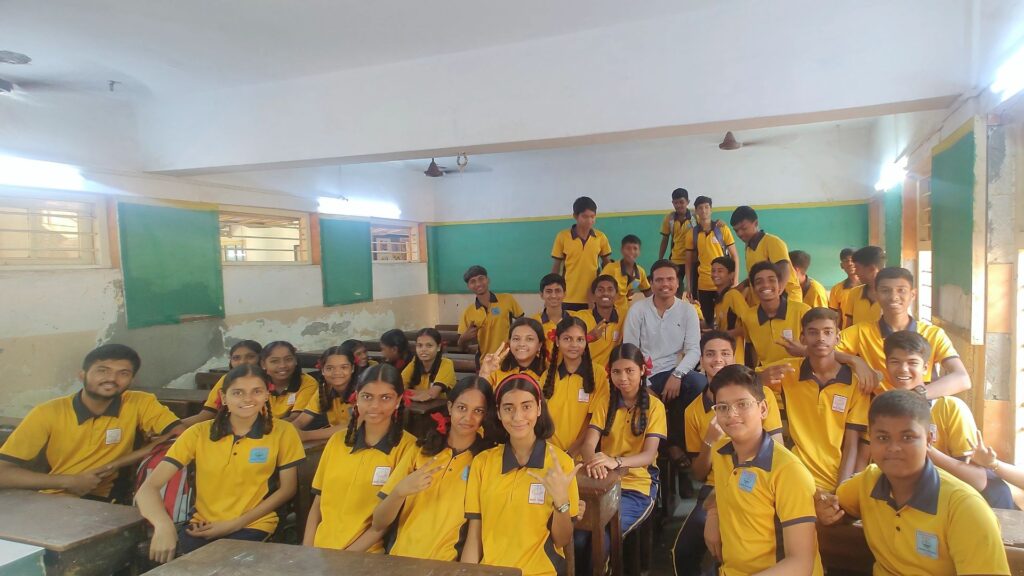
Firsts are always special. They hold a really important and different place. And that is what Narayan Chandra Trust is to Apni pathshala. That’s the place where the journey began. It’s a small place in Virar, where a story of dreams and determination began. It’s where students who once sat in classrooms as eager learners now stand as leaders, managing the same pods that shaped their lives. But this story is about something bigger. It’s about how these two organizations came together to give the students of Nandadeep School a gift that will last a lifetime: the power of digital education! A Bold New Idea Every state has its different set of norms, rules and culture. This may come as a shock to some of the readers, but In Maharashtra, formal computer classes don’t usually begin until after 10th grade. Most parents, too, believe that digital education is something their kids can “learn later.” They apparently think that it’s a waste of time and it’s not worth it for kids to spend time and energy on computer classes. But times are changing, and Narayan Chandra Trust knew that waiting wasn’t an option anymore. They approached Nandadeep School with a vision: to teach kids computer skills early, preparing them for a world that’s already so forward in the digital world. Apni Pathshala stepped in with all the passion they are known for and designed a program that would not just teach but transform. The idea wasn’t just to teach theory. The aim was to give kids something they could use—to help them become independent, confident, and even earn an income after their 10th grade. Pitching the Dream The journey started with a pitch. The team prepared a presentation for the parents and students of Nandadeep School. They laid it all out: Despite initial skepticism (since many parents still believed digital education could wait), the clarity and passion of the pitch won them over. The fact that these classes would be free of cost made the program accessible to everyone, breaking down financial barriers that often limit such opportunities. Now, came the IT moment- the execution of the ultimate plan of bringing magic in those little lives. A 3-Month Program So talking about the plan, the three-month program was designed with precision and taking care of everything important for the kids. The team focused on both theory and practice. The structure was divided into two phases: Mr. Pranav Gorathe, one of the passionate teachers from Apni Pathshala, recalls being assigned a batch of 10th graders. “In Maharashtra, students stop learning computers after 8th grade because all the focus shifts to board exams,” he explained. “I had to start from scratch—literally!” As he shared, the kids didn’t even know how to hold a mouse or start a computer, let alone use Scratch or code. Yes, this may sound shocking to most of you, but this is the ground reality. We do live in two Indias—one, where kids prepare for IITs and work as software developers in big MNCs, and another, where kids don’t even know how to use a mouse—and this is heartbreaking, to say the least! To make matters worse, these students lost almost two critical years of education (2020 to 2022) due to the COVID-19 lockdowns, which further widened the digital divide. Coming back to the classes, as per Pranav Sir, more than the lessons they were an experience. Every week began with a detailed plan, and Saturdays were reserved for listing and reflecting on goals. If targets weren’t met, buffer days were in place to ensure no student was left behind. And then guess what? Something magical happened! The students fell in love with learning. They showed up even on holidays, eager to explore the digital world. In India, if kids show up to study in diwali holidays- you know it’s HUGE! From Struggles to Success You cannot expect your growth without facing any challenges. Similarly, this journey also wasn’t without its hurdles. Many students, like Raj, didn’t even know how to hold a mouse or navigate a computer on day one. But with patience and encouragement, Raj went on to build his own portfolio website—a feat he couldn’t have imagined just a few months earlier! And he wasn’t the only one. The impact wasn’t just academic, it was deeply personal. The school management shared their pride in a heartfelt message: “A big shoutout to Narayan Chandra Trust and the Apni Pathshala pod at Virar for their collaboration with Nandadeep School, enabling 39 students to complete a 3-month program in basic computing, Scratch game development, and WordPress website design.” More Than Just Teachers What makes Apni Pathshala’s approach truly unique is the bond they share with their students. The relationship isn’t the typical teacher-student dynamic. The kids call their mentors “bhaiya,dada,” and the atmosphere is filled with warmth, laughter, and trust. Even the management of the learning pods is done by the kids themselves. They handle attendance, manage social media, and take care of other micro-tasks. This interactive involvement not only builds confidence but also gives them a taste of responsibility and leadership. Looking Ahead The program’s success has sparked new dreams. The team plans to introduce more advanced coding, WordPress, and even connect students with real-world internships. Special thanks to the unwavering support of Mr. Vijay Sarate, the director of Narayan Chandra Trust, the sky’s the limit. This isn’t just a story about teaching computer skills. It’s a story about breaking barriers, challenging outdated norms, and giving kids the tools to rewrite their futures. From Raj’s portfolio website to the games and designs created by the students, every achievement is a proof to what’s possible when passion meets purpose. The collaboration between Narayan Chandra Trust and Apni Pathshala has sparked something much bigger than they might have imagined. It’s not just a program, it’s a movement. A movement that began in a small pod in Virar and now carries the hopes of countless young minds, ready to step
Apni Pathshala 2.0: Innovate. Educate. Elevate
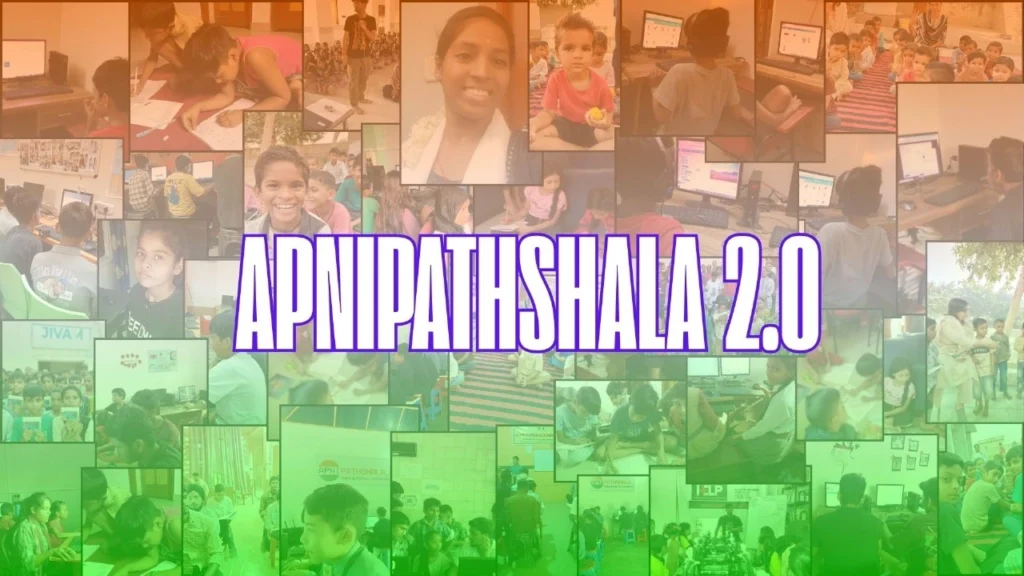
What if we told you there’s a way to bring education to even the most remote communities? A way to make those kids learn coding who don’t even know how to start a computer? A way to help people build skills and become self-reliant? Sounds amazing, right? Well, that’s exactly what Apni Pathshala 2.0 is all about! If you’ve heard of the original Apni Pathshala, you already know it has done amazing work in connecting underprivileged communities with education. But Apni Pathshala 2.0 takes things to the next level. It’s bigger, more organized, and, most importantly, ready to create a lasting impact. Want to know what makes this initiative even more special? What’s Apni Pathshala 2.0 All About? In simple terms, Apni Pathshala 2.0 helps small learning centers, called learning PODs, become powerful hubs of knowledge and digital skills. Over 15 months, these PODs get all the tools and guidance they need to teach students, build websites, and eventually become self-sustainable. Why “2.0”? What’s New? When we first started, Apni Pathshala focused on teaching and sharing updates from PODs. But we realized something important: these learning PODs needed a structured plan to grow and make lasting impact. So, with Apni Pathshala 2.0, we’ve added clear phases, practical goals, and proper timelines. By the end of each phase, we’ll have a proper understanding of each pod’s development and progress. This isn’t just about education anymore, it’s about creating lasting change. Each POD gets personalized support, a step-by-step roadmap, and the tools to make real progress. What’s the Purpose, Goals & Vision? Purpose. First things first, the purpose of Apni Pathshala 2.0 is to create self-sufficient learning centers, known as learning PODs, across India. These are spaces where people can learn digital skills, develop practical abilities, and access education to improve their lives. Goals To achieve this purpose, we’ve set some clear, actionable goals: These goals aren’t just boxes to tick, they’re the foundation of a movement to bring learning and growth to places that need it the most. Vision Now, let’s talk about the dream we’re chasing. We are chasing a future where every community in India has access to a self-sustaining learning center. These centers bridge the gap between those who have access to technology and education and those who don’t. Our vision is to: The Journey: 4 Exciting Phases Phase 0: Getting Started Timeline: Flexible (You decide when you’re ready!)This is where it all begins. We’ll start laying the foundation for your POD’s success. Here’s what happens: By the end of Phase 0, your POD will be equipped and confident to kickstart Phase 1! Phase 1: Building Strong Foundations Timeline: 3 monthsThis phase is all about setting a strong base for your students and POD activities. By the end of Phase 1, your students will be certified in digital skills, and your POD will have a solid online presence! Phase 2: Making Websites Timeline: 3 monthsNow it’s time to take things to the next level. Here the students will learn to create their very own websites! By the end of Phase 2, your students will have real-world skills, and your POD will be quite interactive with all these activities! Phase 3: Independence and Sustainability Timeline: Open-endedThis phase is all about making sure your pod becomes self sustainable and can work with/without you. So that you can watch your POD work and grow independently. By the end of Phase 3, your POD will be fully self-reliant, with a strong community presence and sustainable growth plan! Why Does This Matter? Not everyone has access to good education or technology. Many communities are left behind because they lack resources. Apni Pathshala 2.0 changes this by: The best part? More than learning, it’s about creating opportunities, building independence, and giving people hope. What Happens After Apni Pathshala 2.0? Once Apni Pathshala 2.0 completes its mission of guiding 50 learning PODs through structured phases, don’t you think that journey ends just like that. Over the first six months, PODs move through Phases 0, 1, and 2, with constant support from Apni Pathshala coordinators. The goal is to make sure every POD has the foundation and tools to grow. When a POD reaches Phase 3, it steps into independence. This means they’re ready to operate on their own, managing resources, teaching skills, and staying sustainable without needing external help. While these PODs are moving towards self-sufficiency, the team behind Apni Pathshala is already focused on setting up new PODs. These new learning hubs will go through the initial support stages and eventually join Apni Pathshala 3.0, continuing the cycle of education and empowerment. The process ensures a balance i.e. existing PODs would work independently, while new PODs are nurtured and onboarded. It’s a sustainable system that allows continuous growth and a broader reach. Apni Pathshala 3.0 will take things further, scaling up the network of PODs, mentoring new ones, and creating lasting change. With each new step, the vision of empowering communities through education becomes more real. How Can You Help? This journey isn’t something we can do alone. Whether you’re a teacher, a community leader, or someone who just wants to make a difference, you can play a role. Spread the word, volunteer, or simply support the mission. Together, we can bring the power of education to every corner of the country. Yes, Apni Pathshala 2.0 is about education but more than that it’s about changing lives. This isn’t just a program, it’s a movement. And you can be a part of it.So, what do you say? Let’s Innovate. Educate. Elevate. together!
How CSC Patel Nagar and Apni Pathshala Empower Youth Through Digital Education?.
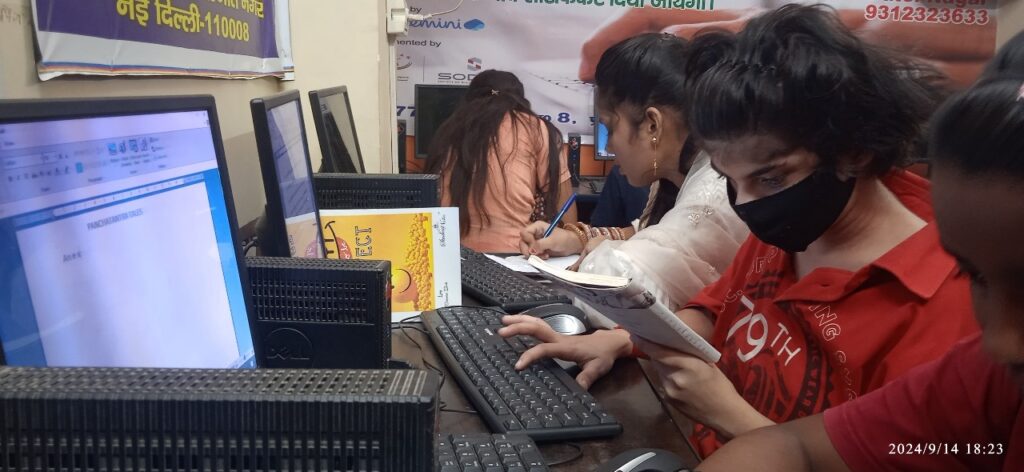
“Education is the most powerful weapon which you can use to change the world.” – Nelson Mandela. Common Service Center (CSC), Patel Nagar, Delhi. Known for years as a place where locals could get help with tasks like filling out forms or submitting online applications for just ₹200, this centre has now become so much more. Thanks to a determined 12th-grade student named Nikhil and the support of Apni Pathshala, this spot is now a hub for digital skills training and growth. Today, this learning pod has become a place where young minds are not just learning new skills but are also gaining the confidence to dream big. This is a story of how Apnipathshala and CSC Patel Nagar are working together to open up new opportunities, bridging the digital gap and promoting community empowerment. From Student to Mentor: Nikhil’s Inspiring Journey Nikhil’s involvement with CSC began as a student himself, with no grand plans other than to learn and just manage the centre. But he quickly grew passionate about giving back, inspired by a teacher who saw his potential and encouraged him to take on a leadership role. With continuous guidance, Nikhil took on the responsibility of running the learning pod, turning it into a proper digital education centre. Initially, CSC had only three computers, and Nikhil’s resources were limited. But he knew the community needed digital skills training, especially for young minds with few opportunities to learn about technology. So, he started teaching and focusing on essential digital skills training like Canva, graphic design, coding, web development, etc. The learning pod quickly attracted a small, enthusiastic group of students eager to learn skills that could open doors for them in the current and future world of technology. The Role of Apni Pathshala in Nurturing Young Digital Minds The growing success of the learning pod soon drew the attention of Apni Pathshala, an organisation with the ultimate mission to make digital education accessible for everyone. Recognizing Nikhil’s commitment and the potential to create an even bigger impact, Apni Pathshala stepped in with a generous donation of 15 computers, transforming the CSC into a proper digital learning pod. Where only a few students could once attend, they could now welcome more learners and structure classes in a way that truly met their needs. The donation not only expanded resources but also gave the pod a new level of credibility, inspiring more families to understand and embrace the value of digital education. “Apni Pathshala’s support was like a turning point,” Nikhil shares. “Now, students don’t have to wait for a computer to be free. Classes are more organised and interactive. With these resources, we’re able to provide quality digital education to more students who need it most.” Balancing School, Teaching, and Center Nikhil’s daily routine is all about balance and commitment. As a 12th-grade student, he’s got a lot on his plate, but he manages to manage everything so passionately. From balancing his own studies to running the CSC, helping locals, and teaching classes at the learning pod, Nikhil’s day is packed. To make things work, he divides the classes into two batches—one in the morning from 10 a.m. to 1 p.m., and another in the evening from 4 p.m. to 10 p.m. Right after school, Nikhil heads straight to CSC, where he starts lesson planning, teaching, and assisting anyone who comes for digital help. He doesn’t just stop at teaching the basics, he goes further. He researches new ways to make his lessons exciting and creates a curriculum that suits his students’ needs. In each session, Nikhil introduces his students to things like coding, web development, and even design tools like Canva. He knows that the more engaging the classes are, the more his students will take away skills that they can really use. Overcoming challenges Nikhil faces plenty of challenges, both at home and in the classroom. Balancing his time between school, teaching, and self-care isn’t easy, and his family often worries about him overloading himself. But the hurdles don’t stop there. Keeping his students engaged can be a challenge, too. In today’s world, students are easily distracted by social media and other influences. Nikhil has noticed that while his students love the practical parts of class, they often lose interest when it comes to theory. To keep them engaged, he’s introduced creative teaching techniques, like games, interactive activities, and projects that make learning more enjoyable. He also faces some doubts from parents, who sometimes worry that their children are spending too much time on “non-traditional” subjects. In a community where mainstream academics are often seen as the only path, digital skills can be misunderstood. “A lot of parents think their kids are wasting time or going in the wrong direction,” Nikhil shares. “But I believe kids need the chance to explore. It’s the only way they’ll find a career path they truly love.” Nikhil’s Vision for the Future When asked about his goals, Nikhil shares his dream of expanding the learning pod. “I have a lot of ideas, even if they’re not concrete yet,” he admits. He imagines creating a larger space where students can access resources beyond just digital tools, like a library where they can read, study, and explore different fields. Though his vision is still coming together, Nikhil’s commitment to uplifting kids is clear. He dreams of a future where every young mind in Patel Nagar and beyond has access to the resources they need to excel in a digital world. His learning pod at the CSC is just the first step toward what he hopes will become a broader movement for educational empowerment. A Message to Aspiring Learners Before ending our conversation, we asked Nikhil if he had any advice for young people pursuing their dreams. His response was simple but impactful: “Consistency is the key to everything. Know your priorities, and make a plan. Once you figure out what’s best for you, you’ll know which distractions to set aside and which goals
Dr. Aniruddha Malpani’s Vision: Transforming Education with Apni Pathshala

In a world where education has become just another business, Apni Pathshala’s MD, Dr. Aniruddha Malpani stands as a light of innovation and purpose. Known for his commitment to reshaping learning, Dr. Malpani recently met with the Apni Pathshala team, leaving them with priceless ideas to ignite self-growth and elevate their mission. This meeting wasn’t just an exchange of ideas, it was a transformative session that inspired the Apni Pathshala team to think bigger and aim higher. Who is Dr. Aniruddha Malpani? Dr. Aniruddha Malpani is an IVF specialist and an entrepreneur who believes in making education accessible and empowering for everyone. He runs the Malpani Infertility Clinic in Mumbai, helping couples fulfil their dream of becoming parents. Beyond medicine, he’s passionate about education and founded Apni Pathshala, which sets up community learning centres to provide digital literacy to kids. Dr. Malpani’s focus is on practical, self-directed learning that goes beyond textbooks. Through this, he aims to equip children with skills for the future, like coding and digital literacy. He also supports innovative startups as an angel investor, driving change in education, healthcare, and beyond. All about the meeting! The meeting kicked off with a warm introduction to the Apni Pathshala team, where each member shared their unique roles and aspirations for the initiative. Dr. Malpani, known for his approachable and enthusiastic nature, listened carefully, eager to help the team move towards creating meaningful impact. The conversation quickly shifted into an engaging discussion about the future of education. Dr. Malpani shared practical ideas for creating learning environments that not only improve outcomes but also develop curiosity and creativity. His vision focused on making education more personal and empowering for students, leaving the team inspired and ready to take bold steps in this cause. Some special insights from Dr. Malpani Creating Safe Learning Spaces “Learning happens where there’s safety.” This simple yet powerful belief drives Dr. Malpani’s educational philosophy. He emphasises that students grow when they feel safe to ask questions, make mistakes, and explore freely without fear of judgement. It’s not just about physical safety but emotional well-being, too- an environment where students feel valued, respected, and encouraged to express themselves openly. This approach fosters not only academic success but also a deeper connection to the joy of learning. The FLIP Learning Model Dr. Malpani also discussed some progressive education solutions. He introduced the team to the flipped learning model, a dynamic shift from traditional teaching. In this approach, students first engage with educational materials independently- through videos, readings, or interactive tools, before class. Classroom time is then used for discussions, problem-solving, and applying concepts in practical scenarios. This model empowers students to take charge of their learning, sparking curiosity and critical thinking. This approach transforms passive learning into an active, student-driven experience. Dr. Malpani’s focus on the FLIP model highlights his commitment to increase classroom impact and inspire lifelong learners. The Power of “Why” “Before you solve a problem, ask why it exists,” Dr. Malpani advises a principle that goes beyond education. This mindset ensures that solutions address root causes, not just symptoms. Teaching students to ask “why” develops a problem-solving mindset, helping them understand the world in a better way. Whether in the classroom or life, this philosophy empowers learners to seek deeper insights and build meaningful solutions, creating a culture of exploration and innovation. Dr. Malpani’s vision for education is about more than teaching. It’s about inspiring a lifelong passion for learning and equipping students with the tools to shape a better future. Empowering learning pods and its students Dr. Malpani envisioned a future where every learning pod and its students could proudly showcase their unique learning journeys through their own websites. Imagine each pod having its own website filled with stories, projects, and reflections saving their growth and inspiring others to learn and dream bigger. These platforms wouldn’t just empower the students involved but also create a vibrant online community of learners who could connect, share ideas, and celebrate their progress. This will also promote the importance of digital literacy among the viewers. Every student’s journey is unique, and by encouraging them to document and share their experiences, educators can help them take ownership of their learning. It’s about more than just showcasing achievements, it’s about inspiring others and developing a culture where growth and creativity are celebrated together. Parental involvement and community microschools Dr. Malpani believes parents play a vital role in education and promotes community microschools as a way to transform learning. He no longer wants to live in the old traditional educational setup. Instead, he gives major focus on progressive education solutions like community microschools. These small, local schools involve parents directly in the education process, offering personalised learning opportunities for students. By focusing on smaller, supportive environments, community microschools provide a flexible alternative to traditional schools. This promotes creativity and deeper connections within the community. Funding with Purpose Dr. Malpani’s commitment to impactful education is evident in his offer of up to ₹1 lakh for projects that drive meaningful growth. However, he emphasises the importance of charging for services rather than offering them for free, as people tend to value what they invest in. He follows the philosophy of letting people invest in their growth. This highlights his belief in sustainable education models where both effort and financial contribution create lasting value. Action-Driven Leadership Dr. Malpani inspired the team with his call to action: avoid HIPPO (Highest Paid Person’s Opinion) and focus on taking bold steps. Instead of waiting for approval, he encouraged the team to learn by doing, promoting the philosophy of “See 1, Do 1, Teach 1.” By observing and sharing knowledge, educators not only grow themselves but also spark learning across their networks. This experiential learning approach empowers educators to lead by example and build a culture of continuous improvement. Importance of This Meeting For the Apni Pathshala team, this meeting wasn’t just about gaining insights, it was more about being challenged to think bigger. Dr. Malpani’s guidance
How a rural learning pod transformed education in Purkhas Rathi?
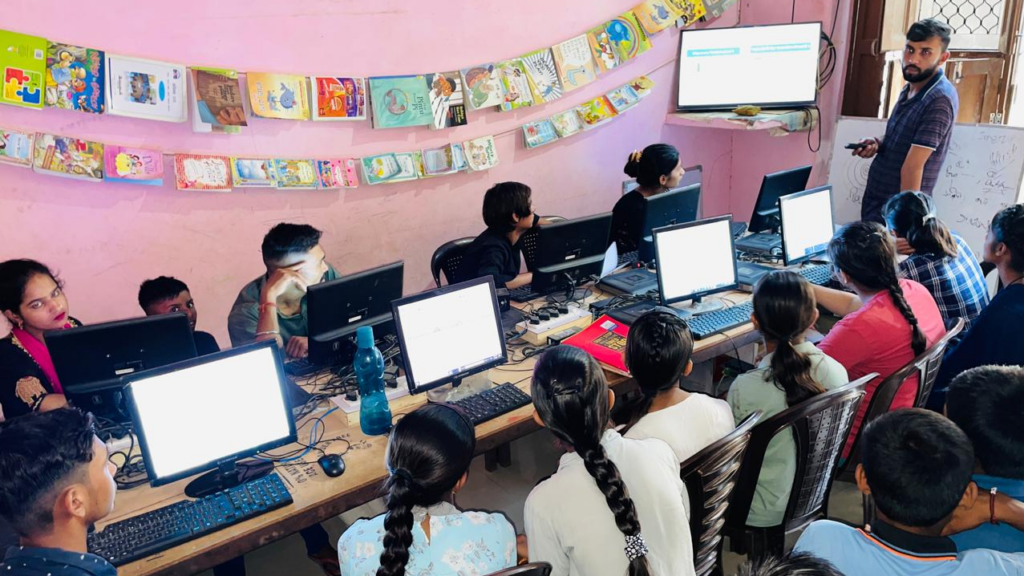
In the village of Purkhas Rathi, a dream has come to life. A dream of giving every child a chance to learn and grow, no matter what. Mr. Kapil Jangra saw a future where kids here could have the same opportunities as any other child.And with the support of LIFI and Apni Pathshala, he began a journey to make that dream real. What started as a small initiative has now become a powerful learning space, where kids don’t just learn—they lead, they grow, and they build a future for themselves! This is the story of transformation in Purkhas Rathi, where you’ll see how hope and courage can write a whole new chapter. The Vision: A new era of learning for Purkhas Rathi In 2020, Kapil Jangra joined Learning Initiatives for India (LIFI), where his work was just to teach students from Class 1 to 5. During his fellowship, he quickly realised that while children were receiving basic education, there would be a great gap once they finished their fifth standard. The lack of a computer lab, essential learning tools, and opportunities for further education in the village made him ask one simple question—What happens to these kids after they finish school? Kapil was determined to find a way to give the children of Purkhas Rathi the skills they’d need for a brighter future. His vision? A computer lab, right in the heart of the village, where kids could learn essential skills to help them succeed in today’s world. But, like many dreams, it seemed impossible at first as he didn’t have the money or resources to make it happen. Still, the man had no plans to give up. He started talking to people, surveying the community to understand their needs and gather support. He even approached the village leader, the Sarpanch, to get support for his idea. Soon, the community started joining. Some donated money, while others brought books, chairs, or furniture—whatever they could offer to help turn Kapil’s vision into a reality. Overcoming challenges with determination You can’t expect to reach greatness without facing any challenge. The road to establishing the learning pod was anything but simple and smooth. Kapil faced numerous challenges, both practical and emotional. As someone with no prior experience in managing such projects, he felt hesitant and unsure, especially when it came to asking for financial help. “Sometimes, doors were slammed in our faces. People doubted us, mistreated us, and I won’t lie, there were moments I felt like crying,” Kapil recalls. But the fire in his heart never extinguished! One of the biggest challenges was the lack of electricity. For months, the learning pod had no reliable power, making it challenging to create a proper study environment. “We had to use lamps and even incense sticks to make the space usable for the kids,” Kapil shared. Even the internet was a struggle as the Wi-Fi barely worked for six months. But despite these obstacles, Kapil and the kids kept going, fully committed to their mission. Another emotional challenge was convincing some parents to send their children, especially girls, to the pod. In a village where education for girls was often considered unnecessary beyond the age of 12, Kapil fought hard to change mindsets. “Meenakshi and Sakshi’s parents initially refused to send them,” says Kapil, remembering the struggle. “Meenakshi’s father was a police officer and wanted to marry her off. But I didn’t give up. I spoke to him again and again, showing him the value of education, and eventually, he agreed.” Meeting Apni Pathshala Where there’s a will, there’s a way. Thanks to Mr. Raman Bhal, the founder of LIFI, Mr. Jangra came into contact with Apni Pathshala: an organisation dedicated to providing quality education and life skills to underprivileged communities. Apni Pathshala’s support was the turning point for the learning pod at Purphas Rathi. They provided computers, electricity, Wi-Fi, and ensured the cleanliness and maintenance of the space. With their support, Kapil’s dream was no longer a distant hope, but a reality. “Apni Pathshala is not just an organisation; they are the backbone of the learning pod,” says Kapil. “They understood our vision and stood by us, providing the resources we desperately needed.” A Pod Managed by the Kids The most amazing part of the learning pod is how self-sustaining it has become. What started as Kapil’s initiative has turned into a space where the kids not only learn but also run things on their own. They’re in charge: creating study schedules, managing computers, and planning activities. “The kids are the true heroes here,” Kapil says proudly. “When I’m away for seminars or training, they handle everything from making study plans, taking photos to even guiding new students. Watching them step up as leaders is incredibly heartwarming.” This sense of ownership is deeply rooted in the students. “When I have to leave, they tell me- ‘Sir, you go, we’ll take care of the pod,’” Kapil shares with a proud smile. “And they don’t just manage it, they’ve made it their own. They take initiative, help each other, and genuinely care about making the pod a place where everyone can grow.” Isn’t this what success looks like? Routine and Growth: Learning Beyond Books The learning pod operates every evening from 5 PM to 7 PM, with a specific no. of students attending each session. On Saturdays, they focus on games and extracurricular activities like dance, singing, and sports to keep the children entertained and teach them life skills such as teamwork. On Sundays, the pod is open for revision and catch-up sessions. The kids themselves decided to contribute a small fee of 300 rupees per month to help cover the expenses for electricity, Wi-Fi, and rent. “They’re incredibly thoughtful,” says Kapil. “These kids are already learning the value of responsibility and self-sufficiency at such a young age.” Looking forward, Kapil hopes to add an English-speaking course to the curriculum to ensure the children aren’t left behind just due to language barriers. “I’ve faced
Creating a Curriculum for Your Learning Pod: A Step-by-Step Guide
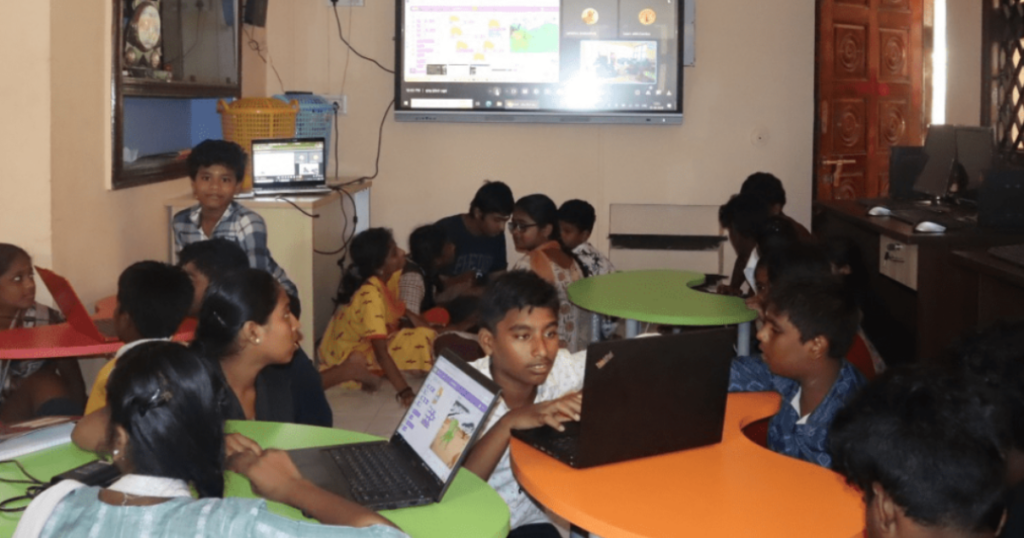
Can you imagine your academic classes without a syllabus? That would be extremely vague. Creating a curriculum for a learning pod is the first and the most important step in the whole journey. One has to make sure it is structured and organised from the beginning. As there are a lot of steps involved, there’s a high chance you might get confused. To make things clearer, here’s a step-by-step guide to developing a structured and effective curriculum that will serve as an invaluable resource for any learning pod. 1. Define Learning Objectives 2. Conduct a Needs Assessment 3. Choose a Learning Model That Fits Your Pod 4. Develop a Weekly and Daily Schedule 5. Select the Right Learning Materials and Resources 6. Set Up Assessment and Feedback Mechanisms 7. Integrate Social and Emotional Learning (SEL) 8. Incorporate Physical Activities and Creative Outlets 9. Adapt and Adjust as Needed Why Choose Apni Pathshala’s Learning Pods? Any talk about learning pods is incomplete without Apni Pathshala. Our collaboration with BeyondExams promises that learning pods are designed with a unique and updated curriculum approach that works for every child’s individual learning needs. We prioritise academic excellence while also nurturing emotional growth and creative expression. In our pods, students find a supportive environment where they can truly grow. So what are you waiting for? Visit Apni Pathshala today and discover how our innovative learning pod curriculum can make a significant difference in your child’s academic and personal development.
From Shadows to Success: Sai’s Journey with ApniPathshala

Life can be unpredictable. It often throws challenges when we least expect them. For Sai Prasad Pujari, an orphan who grew up in the Narayan Chandra Trust orphanage, life’s unpredictability became a medium for his transformation. His journey began with a childhood unlike other kids- At just 5, he lost his parents and he and his younger brother were brought to the Narayan Chandra Trust orphanage in Virar. Their paternal grandmother, who had been raising them on her own, could no longer support them. Life in the orphanage surrounded Sai with other children who had similar experiences of loss, but the environment often felt more like a strict boarding school than a home. Discipline and following routine became the core values of his life. For most of his childhood, Sai felt a deep loneliness despite the people around him. The orphanage was a safe place, but it wasn’t home. At times, he felt invisible and wished he could avoid his reality. Yet, even in this setting, there were small sparks of joy, moments when he got lost in dreams or played with friends. “Time heals everything”, they say. Eventually, he started liking the life out there and began a new journey- his journey! Small Dreams, Simple Wishes Growing up, Sai didn’t allow himself to dream big. The orphanage walls felt like the limits of his world, making it hard to imagine a future beyond them. However, despite the challenges he faced, Sai discovered a small joy in computers. He found himself interested in computer hardware. He loved to open machines, see how they worked and put them back together. Even when someone came to repair computers/machines in the orphanage, he used to sit beside him and see how he did it. The focus, interest and passion was quite visible in his eyes. While it might not have seemed like a grand dream to others, for Sai, it was his passion! Every time he successfully repaired a device, he felt a small victory, a reminder that he could create something from nothing. This passion for technology gave a sense of ambition, allowing him to have some goals. “Engineer banna hai” was his reply to every question related to his career. And that was his first step towards his destiny. Turning Point of his Life! As Sai approached his 18th birthday, he faced a new challenge: the orphanage policy that required children to leave the place and find jobs upon turning 18. Moreover, he was 2 years older than his classmates due to late admission. So, it was in class 10th when he faced this crisis. Legally, the trust couldn’t keep him any longer, and he had to step into the world on his own. Suddenly, the reality of life outside the orphanage struck him. This is because he never thought about the world beyond those walls. He never thought of the future. His daily routine involved getting up, eating breakfast, going to school and then sleeping. Sai felt an overwhelming fear—a fear of not knowing where to go or what to do next. The fear of the unknown! Life was challenging, and every day brought its own set of uncertainties, but through it all, he held onto that quiet dream. Determined to create his own path, Sai sought help from after-care NGOs in Mumbai. There he learned the importance of gaining new skills and exploring internships and freelancing. He learnt about the software part of computers and learnt skills in that domain. He enrolled in various courses, slowly and steadily building a skill set that would eventually make him grow. During this period, Sai completed his 11th and 12th grades while staying at Narayan Chandra Trust. He was allowed to stay there on several conditions- he had to get good grades, follow a strict routine, do some chores like cleaning and most importantly, discipline. Without thinking much, he agreed. This is because they provided him shelter and support when he thought everything was over. Balancing his studies with daily chores in the orphanage wasn’t easy, but he did it. Eventually he completed his schooling and enrolled himself in Bsc. in Information Technology in college to learn more about computers. A Life-Changing Connection Here comes the important plot twist of his life- the entry of Apni Pathshala & BeyondExams! So, as Sai completed his schooling and started his graduation, the orphanage at Narayan Chandra Trust was shut down. The money that was kept for it was invested in building a computer learning pod in its place- Apni Pathshala’s learning pod! To make education and digital literacy reach every corner of India, this transformative idea was Apni Pathshala’s MD, Dr. Aniruddha Malpani’s brainchild. He was a part of the first batch, so yes, it was special. Crossing paths with ApniPathshala marked a turning point in his life. Along with other kids with unprivileged backgrounds, he practised computers and learnt different concepts. But, there was this challenge- initially, Sai struggled to adapt to the curriculum, as it was very unstructured and he felt overwhelmed. But then BeyondExams came into the picture and reignited the fire of learning. They provided him with a structured curriculum that guided Sai and all the other kids through the path they chose. Because of the collaboration between BeyondExams and Apni Pathshala, he discovered a supportive platform that allowed him to pursue his interests without being held back by his age. Sai realised he could explore various skills and secure internships, allowing him to take important steps toward his dreams. “It was like a new beginning for me,” he said. From Student to Mentor to Manager With the encouragement of ApniPathshala and BeyondExams, Sai began mentoring other children from similar backgrounds. For the first time, he was no longer the quiet, introspective boy living on the sidelines. He was a mentor, a guide, and a friend. Guiding these children gave him a sense of purpose he had once thought impossible. He could see himself in them—their fears, their uncertainties,
